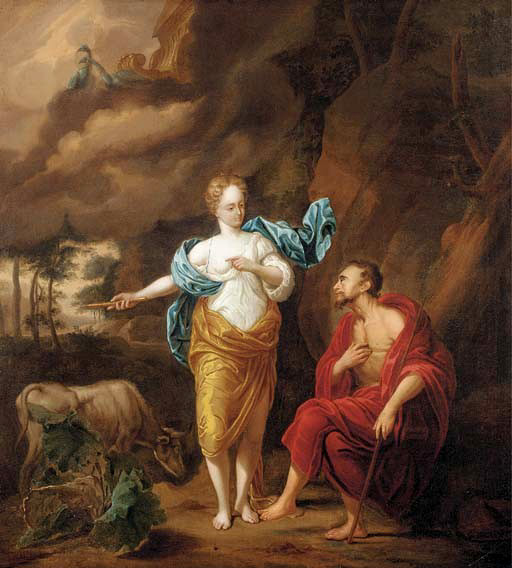
Io: Flight from Ghost and Gadfly
Io was the daughter of the oceanid Melia and Inachus, a river god and the first king of Argos. Like Callisto, Io decided to live a chaste life. Her resolve was often tested as she was beautiful and had to fend off many suitors. She repelled them all effortlessly. Her troubles began, however, with a series of disturbing dreams. In these night visions, Io saw images of haunting green-haired girls who lurked in forest groves and disordered the wits of travelers. Along with these girls was Zeus who whispered pleas of love to the frightened Io. He begged her to lie with him in the verdant meadows of Lerna. One morning, Io spoke of these dreams to her father, Inachus. Inachus consulted the delphic Oracle which commanded him to banish Io forever, lest the enraged Zeus strike down every mortal in his kingdom with his notorious thunder bolts. So, poor Io was banished. Soon thereafter, when the rivers joined to lament the transformation of Daphne to a tree following Apollo's relentless pursuit, Inachus alone remained apart from the others, for he was lost in a swell of tears over the daughter he would never see again. Although her father couldn't see her, Zeus certainly did. Io was walking along the outermost tributaries of her father's tear rich stream, so as to remain, though unseen, close to the father she was forced to forsake. Sensing Io's distress, Zeus invited her to recline in a grove of trees where the fair Io would find cool shade against the noon time sun. Remembering her dream, Io fled across the fields of Lerna and into the concealing canopies of Lycrea, where she then beheld a gathering storm cloud: Zeus in his proper form. Before the designing god could make defeat of her virginity, Hera transformed Io into a bull. Suspecting that this transformation wouldn't deter her lustful husband, Hera summoned a gadfly to constantly sting Io, causing her to constantly move in a vain effort to escape the cruel, bothersome insect. As if that were not sufficient torment, Io was also watched by Argus, the giant monster with a hundred eyes. He proved an effective watchman, for his eyes slept at different times and he could always watch the poor tormented Io with the eyes that remained awake. At Zeus' command, Hermes, in the guise of a shepherd,approached and befriended Argus. Once he has gained the other's trust, Hermes played such soft music for him on the lyre that it caused all the eyes to drift off to sleep. Zeus then struck off the monster's head. Despite the success of this plan, Io was still impossible to retain, as she kept moving due to the gadfly's constant pursuits. Also, she was now pursued by Argus' enraged ghost. As ghosts needed no sleep, Argus couldn't be lulled into slumber again. Io fled across the world; to Dodona, the prophetic oak who pronounced her as Zeus' bride. She also encountered Prometheus, chained to a rock as a punishment for bringing fire to the mortals. Though he suffered the pains of having eagles gnawing on his liver, Prometheus also told Io a prophecy of her eventual worship in Egypt and encouraged her to find refuge there. Io fled to the Egyptian desert, where the gadfly perished and Argus' ghost was repelled by deities sympathetic to Io. It was there that Zeus finally encountered her. Wearied by the dogged pursuits of the ghost and gadfly, Io allowed Zeus to approach her. With a touch of his hand, Zeus restored her back to the form of a woman and at the same time also made her pregnant with Epaphus, whose name means "he of the touch." Io remained in Egypt, where she was worshiped as the goddess Isis. Her son Ephaphus would also experience an apotheosis, eventually becoming identified as the bull-god Apis.
THE SOUTHWORTH PLANETARIUM
207-780-4249 www.usm.maine.edu/planet70 Falmouth Street Portland, Maine 04103
43.6667° N 70.2667° W
Altitude: 10 feet below sea level
Founded January 1970
Julian Date: 2459026.16
2019-2020: CLXIX
THE DAILY ASTRONOMER
Thursday, July 2, 2020
Remote Planetarium 57: Intrinsic Variable Stars I - Cepheids
Yesterday we discussed the two main types of extrinsic variable stars: eclipsing binaries and rotating stars. Today, we begin our discussion about intrinsic variable stars, those stars whose variability results from processes occurring within the star, itself. As we shall see, the different types of intrinsic variable far outnumber the extrinsic, hence the necessity of dividing the intrinsic variable lesson into more than one part.
The chart below shows a variable star "tuning fork" diagram. While the extrinsic variables subdivide only into two categories, the intrinsic variables subdivide into two categories that each contain multiple subdivisions. Today's RP focuses on Cepheids, one of astronomy's most important types of variable stars. Astronomers were able to use these stars to determine the distances of extremely remote objects, such as globular clusters and galaxies.
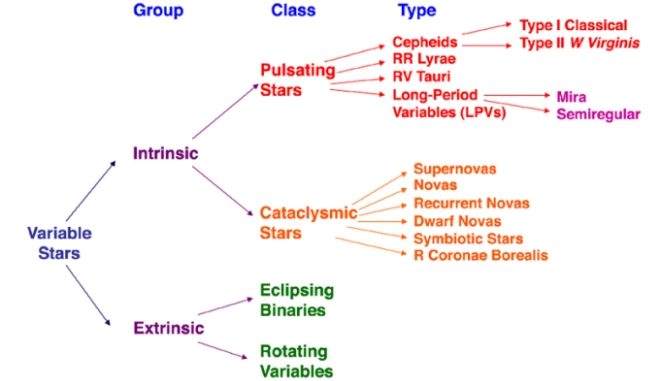
We begin with a quick review about stellar luminosity, defined as a star's energy output over the period of one second. A star's luminosity depends on its size and effective temperature. Recall the following equation introduced in RP # 37:

The luminosity increases with the square of the radius and the fourth power of the temperature. If a star expands, its size increases, but its effective temperature will also increase. As its name implies, "pulsating variables" expand and contract. Consequently, a pulsating star's size and temperature -and therefore, luminosity- vary throughout each pulsation cycle. Cepheids, one of the best known types of pulsating variables, operate on this same principle. The mechanism responsible for Cepheid pulsation involves ionized and doubly ionized helium. Helium is ionized when it loses one electron and when it loses both electrons is doubly ionized.
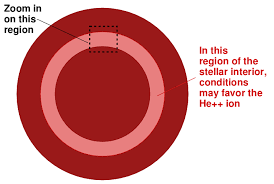
As the helium layer contracts due to the Cepheid's gravitational attraction, it absorbs heat and in the process becomes more ionized. Doubly ionized helium is more opaque than singly ionized helium or neutral helium. As it is more opaque, it collects more heat. (As an analogy, think of how darker colors absorb more heat than lighter ones.) As the doubly ionized helium layer heats up, it begins to expand. The expansion causes the layer to cool. The cooled helium then regains an electron to become singly ionized. The singly ionized helium, being less opaque, allows more heat to escape. The expansion ceases and the gravitational contraction resumes. The compressed layer then heats, the helium becomes doubly ionized and the layer becomes more opaque. The heating induces the next expansion and the cycle continues again.
Cepheid variables have proven to be immensely useful for distance determination purposes. A cepheid's variability period is directly related to its luminosity, hence the term period-luminosity relation. The more luminous the cepheid, the longer the period. Astronomers recognize two types of Cepheids, I and II.
- Type I Cepheids: a.k.a. "Classical Cepheids." High metallicity, Population I stars that are between 4- 20 more massive than the Sun. They can also be as much as 100,000 times more luminous.
- Type II Cepheids: Low metallicity, Population II stars of low mass (less than the Sun.)
Each type has its own period luminosity relation curve, as seen below.
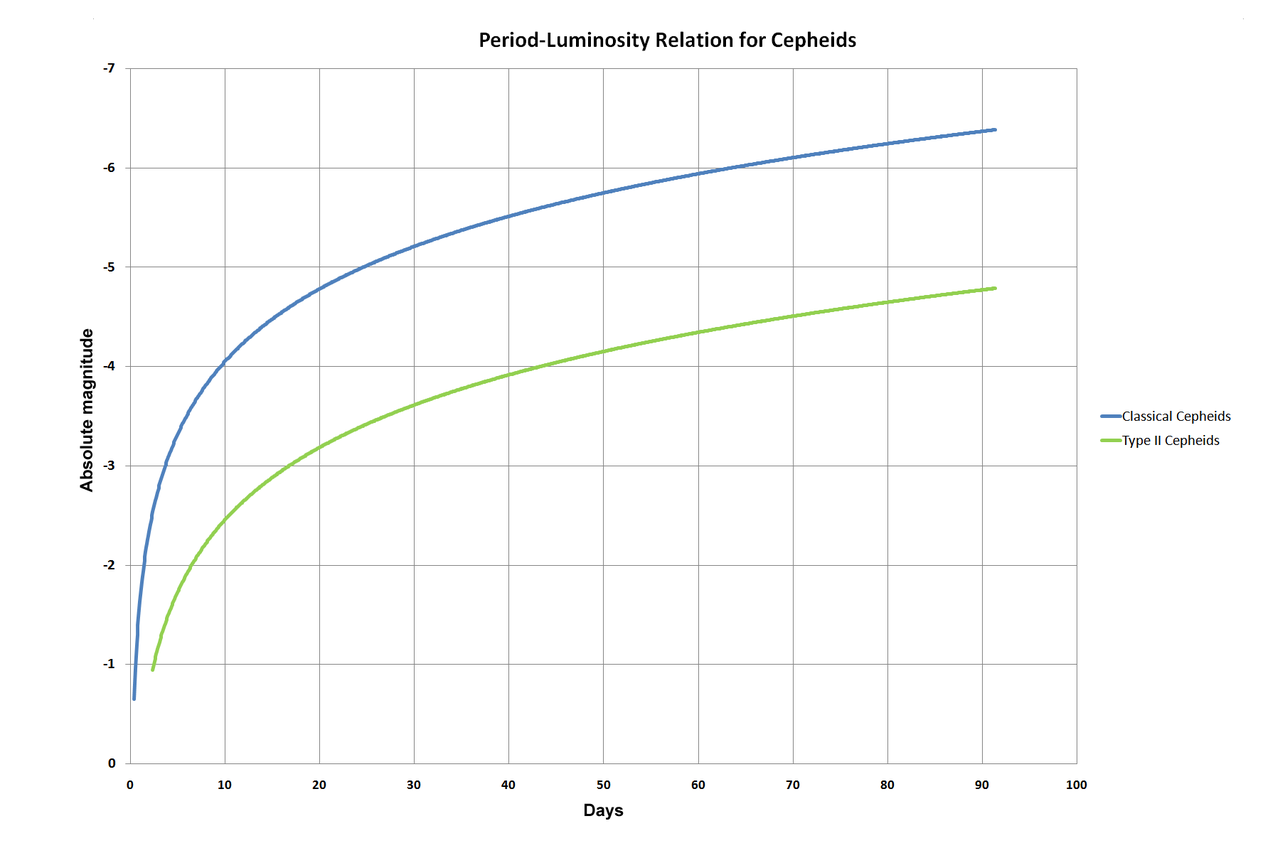
The horizontal line indicates the pulsation length period in days) and the vertical shows the star's corresponding absolute magnitude, which is related directly to its luminosity. By observing the Cepheid's period, an astronomer will automatically know its absolute magnitude. By comparing the absolute magnitude with the apparent magnitude that was directly observable, the distance to the cepheid variable, and by extension to the galaxy containing it, could be ascertained.
__________________________________________
How did they work out the Period-Luminosity Relation?
Henrietta Swan Leavitt discovered the Period-Luminosity Relation by observing Cepheid variable stars with the Small Magellanic Cloud. This "Cloud" is a satellite galaxy to the Milky Way at an estimated distance of 160,000 light years from Earth. Even though the SMC has a diameter of 7,000 light years, we can assume that all the stars are at more or less the same distance from us. Similarly, we can assume that every citizen of Los Angeles County is at the same distance from Portland, Maine. Professor Leavitt surveyed the Cepheid variables within the SMC and noticed that the brightest Cepheids exhibited the longest variability periods. Through careful observations, she determined a correlation between the Cepheid variable's brightness and variability period. These observations served to establish this relationship. Direct distance determination of Delta Cephei, the very first Cepheid discovered - hence, the name - provided astronomers with that Cepheid's luminosity. This knowledge provided them with the key to establishing the actual period luminosity relation.
[Note: by measuring Delta Cephei's distance through parallax, they could compare its apparent brightness and distance to determine the star's actual brightness, or luminosity. Distance, apparent brightness and absolute brightness are the three factors involved in the "distance modulus" equation. The determination of two yields the value of the third. Leavitt's discovery enabled astronomers to use Cepheid variables as distance indicators.
_________________________________________________________
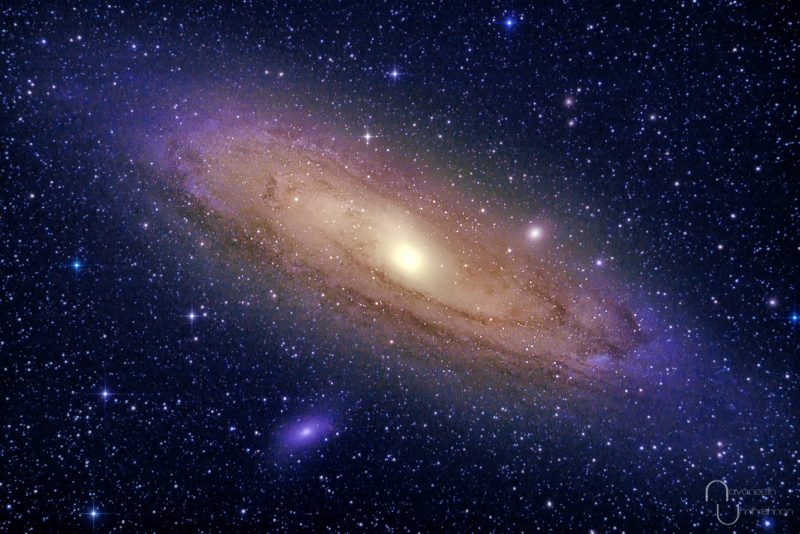
Edwin Hubble is credited with having used Cepheid variables to ascertain the distance to the Andromeda Galaxy. He calculated its distance to be around 800,000 light years, less than half the currently accepted value of 2.2 million light years. He based his calculations using the light curve now known to correspond to the second Cepheid variable type. While this initial distance value was woefully inadequate, it did firmly place the "Andromeda Nebula" outside the Milky Way Galaxy's boundaries.
As we will discover, there are other pulsating variables apart from the Cepheids. They, too, have often proven quite useful to astronomers in their efforts to surmise the true extent of the cosmos.
More on variable stars next week.
Quiz tomorrow.